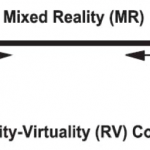In their paper [PDF, 200K], “FROM VIRTUALITY TO REALITY AND BACK”, the authors presented an overview of the “reality” concepts in design and related areas, including Milgram and Colquhoun (1999)’s Reality to Virtuality continuum, as well as a classification of reality concepts according to correlation between perception and action and level of interaction.
Tag: virtual reality
A New Encounter with Alice

Three of our first year students, Jesse Meijers, Marjolein Schets and Jim Steenbakker, did a nice project in the context of cultural computing. “The goal of the project was to create a new form of presence and user experience by turning the visitors sense of reality upside down through the use of modern technology. The rooms built for this project were based on scenes from the book `Alice’s Adventures in Wonderland’. We decided to build a new room. Our room is based on the scene where the tarts of the Queen of Hearts2 get stolen. The visitor will accidentally perform the theft. The rooms purpose is evoking a feeling of confusion. The room is an infinity mirror room which contradicts the visitor’s sense of reality, proportion and boundaries.”
[The final project report: “A New Encounter with Alice” 1.3M, PDF]
Beyond L$: Values across the Virtual and the Real
Jun Hu, Serge Offermans
Abstract Virtual societies and virtual worlds are now patriotically a part of lives of many people, especially the younger generations who have been growing up with the internet and mobile networks. Negative influences such as internet addiction and aggressive behavior have drawn attentions from researchers. As a result the focus has been on how to prevent them from spending too much of time in virtual societies and virtual worlds. A more interesting approach would be, by positively transferring or exchanging the values between the virtual and the real, to reach a more balanced experience in both worlds.
ALICE’s adventures in cultural computing
Jun Hu, Christoph Bartneck, Ben Salem, Matthias Rauterberg
Abstract – In the paradigm of cultural computing, different cultures need different approaches to address the cultural determinants that strongly influences our way of thinking, feeling and worldview in general. For the western culture, our answer to this need is an artistic and interactive installation (ALICE) based on the narrative ‘Alice’s Adventures in Wonderland’. To address the western culture characteristics highlighted in the narrative, six stages were selected and implemented as an interactive experience. From start to end, the user undergoes an immersive environment that integrates embodied and virtual agents, real and nature mimicking, and both virtual and augmented reality. Every stage challenges the hardware and software design to provide the intended experience, which at the overall system level yet have to be seamlessly integrated. A distributed and multi-layered architecture is designed to accommodate this need. After several pilot tests, the installation is ready as a cultural computing platform for the experiments that address the western cultural determinants.
Keywords: Alice’s Adventures in Wonderland; western culture; cultural computing; human-computer interaction; HCI; art installation; interactive installation; virtual agents; virtual reality; augmented reality; immersive environments; Alice in Wonderland
Applying Virtual and Augmented Reality in Cultural Computing
Christoph Bartneck, Jun Hu, Ben Salem, Razvan Cristescu and Matthias Rauterberg
Abstract— We are exploring a new application of virtual and augmented reality for a novel direction in human-computer interaction named ‘cultural computing’, which aims to provide a new medium for cultural translation and unconscious metamorphosis. In this application both virtual and robotic agents are employed as an interactive dialogue figure. The main objective of this project is to create an interactive installation named ALICE that encourages people in Western culture to reflect on themselves, based on the narrative of ‘Alice’s Adventures in Wonderland’ which address issues such as logic, rationality, and self.
Index Terms— Alice in Wonderland, cultural computing, experience, sub-
consciousness.


